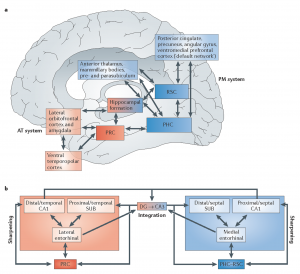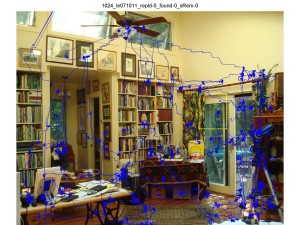
Fig. 2 from Ranganath and Ritchey, 2012. Network of brain regions supporting memory-guided behavior. This testable framework may prove to have some arrows that are missing or that are a little off the mark, but we think it’s a good place to start.
Forming memories. What are neurons doing as we explore our surroundings that leads to the expression of memory for those surroundings? Depending on the task demands, cells in the medial temporal lobe are implicated in this process, including those in the dentate, CA3/CA2(yes)/CA1, subiculum and entorhinal cortex. We’re also interested in connected areas that are thought to interact in this process, using memory to improve actions.
Memory consolidation. We are also interested in what neurons do after periods of exploration. Memory for a given experience can be disrupted in various ways immediately or shortly afterwards, whereas the same disruptions lose their effectiveness with elapsed time from the experience. The process of becoming resistant to interference (‘memory consolidation’) has been described for over a century, yet the neural basis for this phenomenon is still unclear. We record neural ensemble activity before, during, and after an experience, to see whether or not the activity may support a kind of stabilization of the memory. One (albeit contentious) candidate mechanism is memory trace reactivation that coincides with sharp-wave ripples in the hippocampus.
We only know whether something is remembered or forgotten by observing changes in behaviors that we attribute to the memory for prior experiences. This can be measured with verbal report, time to locate or respond to target items in the environment, predictive responses to predictable (learned) stimuli, and changes in exploration that tell us about perceived novelty. We compare the responses of neurons/neural populations for items or events that are remembered to the responses when trials are forgotten or when they are first encountered. See below for more details.
Changes in hippocampal activity during memory-guided visual search
Relevant publications:
-
Leonard TK and Hoffman KL (2017) Sharp-Wave Ripples in Primates Are Enhanced near Remembered Visual Objects. Current Biology 27(2):257–262. doi: 10.1016/j.cub.2016.11.027
- see Duszkiewicz and Peyrache dispatch: http://dx.doi.org/10.1016/j.cub.2016.11.058
- Montefusco-Siegmund R, Leonard TK and Hoffman KL (2017) Hippocampal gamma-band synchrony and pupillary responses index memory during visual search. Hippocampus 27(4)p. 425-434. doi: 10.1002/hipo.22702
- Dragan MC, Leonard TK, Lozano AM, McAndrews MP, Ng K, Ryan JD, Tang-Wei DF, Wynn JC, and Hoffman KL (2016) Pupillary responses and memory-guided visual search reveal age-related and Alzheimer’s-related memory decline. Behavioural Brain Research DOI:10.1016/j.bbr.2016.09.014
- Wynn JS, Bone M, Dragan MC, Hoffman KL, Buchsbaum BR and Ryan JD Selective scanpath repetition during memory-guided visual search (2016) Visual Cognition 24(1) 15-27 DOI:10.1080/13506285.2016.1175531
- Talakoub O, Gomez Palacio-Schjetnan A, Popovic MR, Valiante TA, Hoffman KL (2016) Closed-loop interruption of hippocampal ripples through fornix stimulation in non-human primates. Brain Stimulation DOI: 10.1016/j.brs.2016.07.010
- Leonard TK, Mikkila JM, Gerrard JL, Kaping D, Patel S, Eskandar E, Womelsdorf T, Hoffman KL (2015) Sharp wave ripples during visual exploration in the primate hippocampus. The Journal of Neuroscience 35(44):14771-14782 doi: 10.1523/JNEUROSCI.0864-15.2015
- Hoffman KL, Dragan MC, Leonard TK, Micheli C, Montefusco-Siegmund R, Valiante TA (2013) Saccades during visual exploration align hippocampal 3-8 Hz rhythms in human and non-human primates. Frontiers in Systems Neuroscience 7:43. doi: 10.3389/fnsys.2013.00043
- Chau VL, Murphy EL, Rosenbaum RS, Ryan JD and Hoffman KL (2011) A flicker change detection task reveals object-in-scene memory across species. Frontiers in Behavioral Neuroscience. 5:58. doi: 10.3389/fnbeh.2011.00058
- Chawla MK, Guzowski JF, Ramirez-Amaya V, Lipa P, Hoffman KL, Marriott LK, Worley PF, McNaughton BL, Barnes CA (2005) Sparse, environmentally selective expression of Arc RNA in the upper blade of the rodent fascia dentata by brief spatial experience. Hippocampus 15(5):579-586.
- Hoffman KL, McNaughton BL (2002) Coordinated reactivation of distributed memory traces in primate neocortex. Science 297:2070-3.

